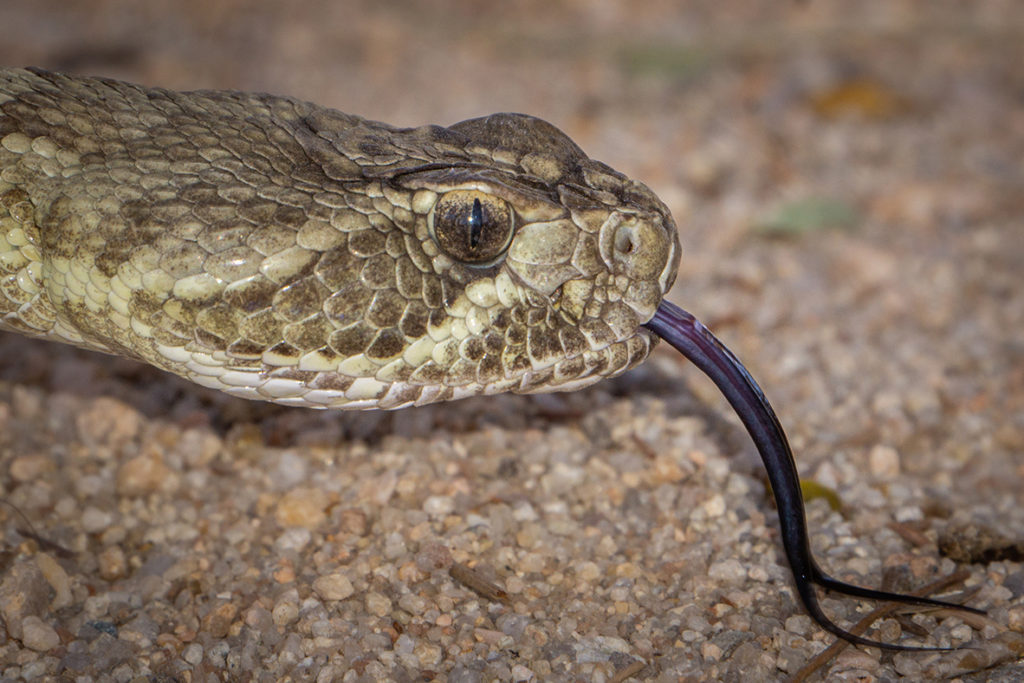Crotalus scutulatus, AKA the Mojave Rattlesnake, is a pit viper known for its particularly powerful neurotoxic-hemotoxic venom, one of the most potent in the world. The Mojave Rattlesnake can be found in the arid desert regions of the Southwestern United States and Northern to Central Mexico.
A common nickname for these snakes is “Mojave Green”, because many of them are a noticeable green color. This name, however, is inaccurate as their color range includes green, brown, yellow, grey and some occasional lighter-colored varieties.
There are two recognized subspecies of C. scutulatus – Crotalus scutulatus scutulatus (Mojave Rattlesnake) which is found in the United States from eastern California into west Texas; and C. scutulatus salvini (Huamantlan Rattlesnake) found in Mexico from Hidalgo through Tlaxcala and Puebla to southwestern Veracruz.
Description and Behavior
The Mojave Rattlesnake (interchangeable spelling: Mohave Rattlesnake) is a large, heavy bodied rattlesnake. They can reach up to 4.5 feet (1371 mm) but most are not larger than 3.25 feet (990 mm). They possess all the common physical attributes of other rattlesnake species: heat-sensing pits on the face, keeled scales, and prominent rattles on the tail.
Patterning closely resembles that of the Western Diamondback (Crotalus atrox), and these snakes are commonly confused in areas where there is range overlap. Their color can range between different shades of grey, green, yellow, and brown with various undertones. Crotalus scutulatus have 27-44 dark colored blotches with solid light borders and the tail has black and white banding above the rattle. Crotalus scutulatus have 25 rows of dorsal scales that are not individually speckled, and they have between 2 and 4 large, anteriorly-situated supraocular scales.

Crotalus scutulatus is most active from April to September – diurnal when it’s cooler and nocturnal during the hot summer months. Once it gets cold, Crotalus scutulatus brumate – meaning they lower their metabolic rate while not actually going into full hibernation. They do this either alone or in small groups with other snakes. Mojave Rattlesnakes are ambush predators that feed primarily on small rodents and lizards.
They have a reputation for being more aggressive than other snake species, with reports of people being “chased” and “attacked” by Mojave Rattlesnakes. However, these claims are unfounded and not supported by scientific literature. Their behavior is like that of any other rattlesnake, defensive and will only attack and envenomate to protect themselves when provoked.
Venom: Hemorrhagic vs Neurotoxic
Again, the Mojave Rattlesnake is well-known for it’s highly potent venom, which come in two varieties – one that will shut down your body or another that will have you internally bleeding to death. These venom types are simply referred to as Type A and Type B, respectively, and which one you get depends on where you found the snake.
Type A venom is neurotoxic, containing a combination of peptides and enzymes that shut down the nervous system by interrupting communication between neurons. Type B venom is hemorrhagic/hemotoxic and can cause symptoms such as disorientation, tissue damage, difficulty clotting blood, and hemolysis.
Up until recently, only venom Type A had been documented in Crotalus scutulatus, but after decades of inquiry regarding symptoms that were unusual for neurotoxic envenomation, researchers dove deeper into the subject and were able to clearly identify both venom types. Mojave Rattlesnakes with Type B venom are thought to be mostly isolated in a region of South-Central Arizona, but few have been documented elsewhere. What type of venom the snake has is dependent on what is most effective for the prey they hunt in that particular area.
Friendly Reminder
Rattlesnakes are vital to the balance of our ecosystems. They do not “attack”, but rather defend themselves when they are scared. It’s uncommon for someone to be bitten by a snake they were unaware of or trying to avoid. Typically, when bites occur, the snake was being provoked and had no escape route. It’s especially important to remember this when discussing species like the Mojave Rattlesnake (Crotalus scutulatus) – just because they are more venomous than other snakes does NOT mean that they are also more aggressive, which is the common assumption.
“Rattlesnakes are also among the most reasonable forms of dangerous wildlife: their first line of defense is to remain motionless; if you surprise them or cut off their retreat, they offer an audio warning; if you get too close, they head for cover. Venom is intended for prey so they’re reluctant to bite, and 25 to 50 percent of all bites are dry – no venom is injected.” Leslie Anthony. Snakebit: Confessions of a Herpetologist. Greystone Books, 2008.